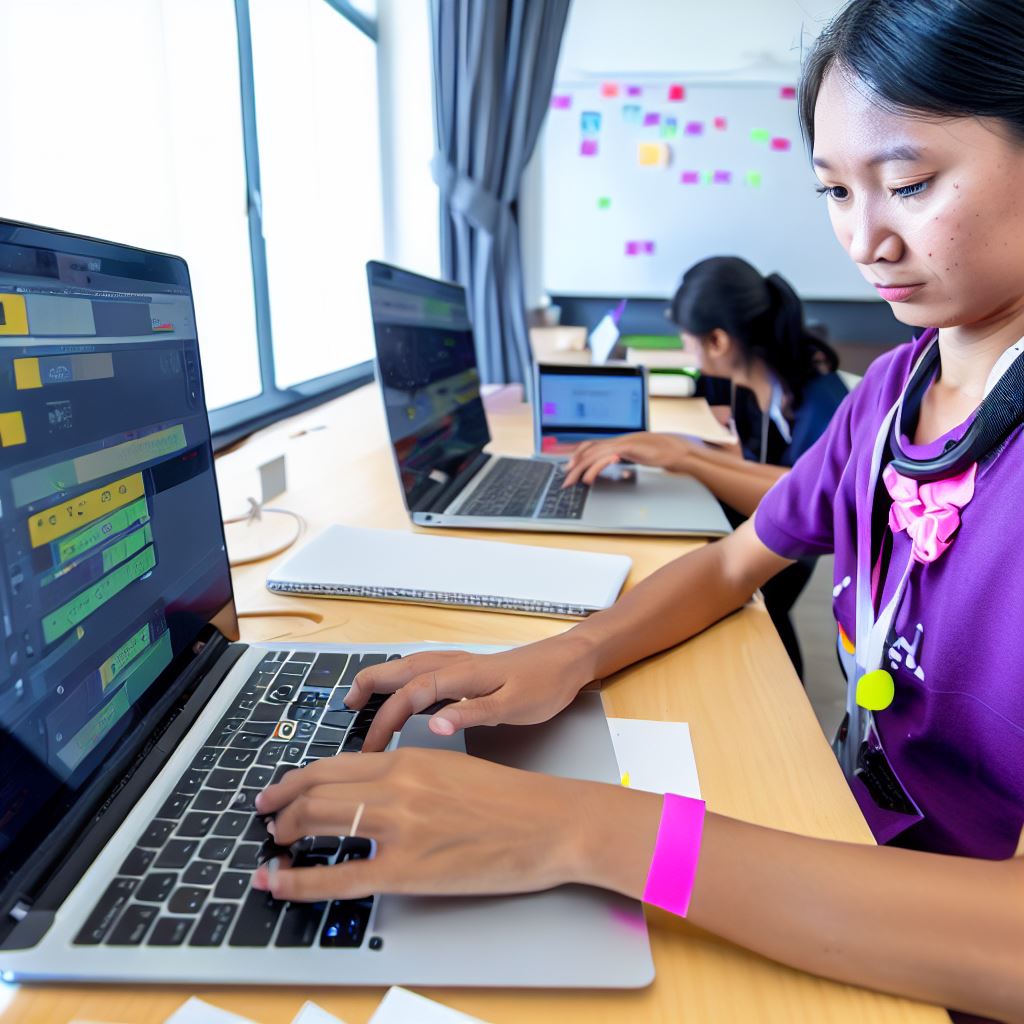Transitioning from Block Coding to Text-based Programming
Last Updated on September 15, 2023
Introduction
Transitioning from block coding to text-based programming is vital in the growth of a coder.
Block coding involves dragging and dropping pre-made code blocks, while text-based programming involves writing code manually using a programming language.
The need to transition from block coding to text-based programming is becoming increasingly important.
While block coding is great for beginners and visual learners, text-based programming offers more flexibility, control, and advanced features.
In this blog post, we will explore the reasons why transitioning from block coding to text-based programming is essential.
We will discuss the limitations of block coding and how text-based programming can overcome these limitations.
First, we will define block coding and text-based programming.
Block coding is a visual programming language that simplifies coding by using blocks of pre-written code that can be manipulated.
On the other hand, text-based programming involves writing code manually using a programming language syntax.
Next, we will delve into the increasing need for transitioning from block coding to text-based programming.
As students progress in their coding journey, they may require more advanced features and a deeper understanding of programming concepts, which text-based programming can provide.
This section serves as an introduction to the importance of transitioning from block coding to text-based programming and sets the stage for deeper exploration in the subsequent sections.
Understanding Block Coding
Block coding is a visual programming language that allows users to create programs by dragging and dropping blocks of code.
The benefits of block coding for beginners
- Easy to understand: Block coding uses graphical elements that make it easier for beginners to comprehend and follow.
- Visual representation: Blocks visually represent code elements, helping beginners grasp programming concepts easily.
- Error reduction: Block coding reduces syntax errors as users can only select compatible code blocks.
- Immediate feedback: Beginners receive instant feedback on their code, fostering a sense of accomplishment and motivation.
Popular block coding platforms and languages
- Scratch: Scratch is a block coding platform that targets beginners and allows them to create interactive projects.
- Blockly: Blockly is a web-based library that provides a block coding interface, used by various platforms and languages.
- App Inventor: App Inventor combines block coding with mobile app development, making it suitable for beginners.
- Tynker: Tynker is a block coding platform designed for children, offering interactive lessons and game-based learning.
Limitations and challenges of block coding
- Limited capabilities: Block coding may lack advanced features and high-level coding functionalities.
- Transition difficulty: Moving from block coding to text-based programming can be challenging due to the differences in syntax.
- Complex projects: Block coding might not be suitable for complex projects that require advanced programming skills.
- Less flexibility: Predefined blocks can limit the flexibility and creativity of more experienced programmers.
In general, block coding is a visual programming language that offers numerous benefits for beginners.
It simplifies the learning process, provides immediate feedback, and reduces errors.
Popular block coding platforms include Scratch, Blockly, App Inventor, and Tynker.
However, block coding has limitations in terms of advanced capabilities, transitioning to text-based programming, complexity of projects, and flexibility for experienced programmers.
Despite these limitations, block coding remains a valuable tool for learning programming concepts and fostering creativity.
Read: Unlocking Opportunities: Coding Grants for U.S. Students
Advantages of Text-based Programming
Text-based programming refers to writing code using text characters, such as letters, numbers, and symbols, which are then executed by a computer.
Text-based programming languages offer more flexibility and control compared to block coding. Developers can customize and fine-tune their code to meet specific requirements.
They have access to low-level operations and can optimize code for efficiency.
Advantages of Transitioning to Text-based Programming
Transitioning from block coding to text-based programming opens up a world of opportunities and unlocks the full potential of coding.
The ability to write code using text characters empowers developers with greater control and flexibility.
Unlike block coding, which relies on visual blocks for code construction, text-based programming languages require developers to write code manually.
This approach allows for more precise control over the logic and execution of the program.
Text-based programming languages offer a range of advantages, making them a preferred choice for many developers.
The following benefits demonstrate why transitioning to text-based programming is worth considering:
- Increased Versatility: By transitioning to text-based programming, developers gain the ability to work on a vast range of projects. Whether it’s developing a simple script or building complex applications, text-based programming languages provide the necessary tools and flexibility to meet diverse requirements.
- Advanced Functionality: Text-based programming languages offer a wide array of features, libraries, and frameworks that empower developers to create sophisticated and functional programs. These languages provide access to low-level operations, enabling optimization for performance and efficiency.
- Enhanced Problem-Solving: The process of writing code in a text-based environment promotes logical thinking and improves problem-solving skills. By manually constructing code, developers become adept at breaking down tasks, analyzing components, and finding effective solutions.
- Improved Collaboration:
Text-based programming simplifies collaboration among developers. Code can be easily shared, reviewed, and modified in text format, facilitating teamwork and fostering a culture of open-source development. This collaborative approach leads to collective improvement and knowledge sharing. - Career Opportunities:
Proficiency in text-based programming languages opens up various job opportunities. Many employers and organizations require developers who can work with established programming languages. Transitioning from block coding to text-based programming provides a solid foundation for entering the professional programming world.
Popular Text-based Programming Languages for Beginners
For beginners, there are several popular text-based programming languages that offer user-friendly syntax and extensive learning resources:
- Python: Python is known for its simplicity and readability, making it suitable for beginners. With a wide range of applications, including web development, data analysis, and automation, Python is an excellent language to start with.
- JavaScript: JavaScript is extensively used in web development to create interactive elements and dynamic functionality. It is supported by all modern web browsers, making it an essential language to learn for front-end development.
- C: C is considered a foundational language with a concise syntax. It provides a deeper understanding of low-level operations and systems programming. Learning C helps build a strong programming background.
- Java: Java is a versatile and beginner-friendly language widely used for building robust applications. It boasts extensive libraries and documentation, making it easier to learn and work with.
- Ruby: Ruby is renowned for its beginner-friendly syntax and elegant code structure. It is commonly used in web development and allows developers to quickly build prototypes and web applications.
In essence, transitioning from block coding to text-based programming offers numerous advantages.
The freedom, control, and versatility provided by text-based programming languages empower developers to create complex and efficient programs.
With a wide range of beginner-friendly languages available, individuals can embark on their coding journey with confidence and explore various fields of software development.
Read: Demystifying Common Coding Myths for New Learners

Challenges Faced when Transitioning
Discuss the learning curve associated with text-based programming
- Transitioning from block coding to text-based programming can present a significant learning curve.
- It requires a deeper understanding of syntax, structure, and commands to write code.
- Learning a new programming language can be intimidating at first, especially for beginners.
- It involves understanding concepts like variables, loops, and conditionals and how to use them effectively.
- Mistakes in syntax can lead to errors and bugs in the program, making debugging a crucial skill to acquire.
- The learning process can be time-consuming and challenging, but with dedication and practice, it becomes manageable.
Address common challenges and difficulties during the transition
- One common challenge is grasping the new way of thinking in text-based programming.
- It requires breaking down a problem into smaller steps and creating logical solutions.
- Another difficulty is transitioning from the visual representation of blocks to writing lines of code.
- It can be overwhelming to understand how to translate visual concepts into a text-based format.
Additionally, debugging becomes more challenging as errors are not always highlighted visually. - Managing syntax errors and understanding error messages can be frustrating for beginners.
Provide tips and strategies to overcome these challenges
- To overcome these challenges, it is essential to practice regularly and take a step-by-step approach.
- Start with simple programs and gradually increase the complexity as skills develop.
- Utilize online resources, tutorials, and interactive platforms to gain a solid understanding of the programming language.
- Working on real-world projects can help reinforce concepts and improve problem-solving abilities.
- Joining coding communities and forums can provide support and guidance from experienced programmers.
- Seeking feedback and learning from mistakes is crucial for growth and improvement.
Emphasize the importance of continued practice and perseverance
- Transitioning from block coding to text-based programming requires perseverance and continuous practice.
- Consistency is key to developing coding skills and becoming proficient in a programming language.
- Dedicate time each day to code, challenge oneself, and explore new concepts and techniques.
- Embrace mistakes as learning opportunities and persist in solving problems.
- Building a strong foundation in text-based programming takes time, but with determination, one can overcome the challenges.
- Remember, even experienced programmers faced difficulties in the beginning, and perseverance made them successful.
Read: Coding for Creatives: Artists Transforming U.S. Design
Resources and Tools for Transitioning
A smooth transition from block coding to text-based programming can be facilitated by utilizing various resources and tools.
In this section, we will explore some recommendations to make your learning journey easier and more efficient.
Recommended online tutorials and courses for learning text-based programming
- Codecademy: Codecademy offers interactive coding lessons and projects in various programming languages, including Python, JavaScript, and Ruby. Their step-by-step approach is suitable for beginners.
- Udemy: Udemy hosts a wide range of text-based programming courses, both free and paid. These courses are created by industry experts and provide in-depth knowledge and practical exercises.
- Coursera: Coursera collaborates with top universities to provide online programming courses. Their structured program tracks help beginners understand the fundamentals and gain hands-on experience.
Helpful resources, forums, and communities for support during the transition
- Stack Overflow: Stack Overflow is a popular Q&A platform where programmers can ask questions and find solutions to coding problems. It has an extensive community of experienced developers who are often ready to provide guidance.
- Reddit Programming Community: Reddit hosts numerous programming-focused communities, such as r/learnprogramming and r/programming. These communities offer a space for discussions, asking questions, and sharing resources.
- GitHub: GitHub is not only a version control platform but also a hub for open-source projects. Exploring repositories, contributing to projects, and connecting with developers can enhance your learning and understanding.
Information about text-based programming IDEs or editors for beginners
- Visual Studio Code: Visual Studio Code is a popular, free, and open-source code editor. It provides an intuitive interface, syntax highlighting, and offers extensions for various programming languages.
- Sublime Text: Sublime Text is a lightweight and customizable text editor known for its speed and responsiveness. It supports multiple programming languages and offers powerful features like split editing and multiple selections.
- PyCharm Community Edition: PyCharm Community Edition is a dedicated Integrated Development Environment (IDE) for Python. It offers intelligent coding assistance, debugging tools, and easy project management.
Personal recommendations and success stories
- Start with a small project: Begin by tackling a simple project in text-based programming to get hands-on experience and build your confidence gradually.
- Practice regularly: Consistent practice is key to mastering text-based programming. Set aside dedicated time daily or weekly to work on coding exercises and projects.
- Join coding communities: Engaging with coding communities, such as local meetups or online forums, can provide valuable support, feedback, and networking opportunities.
- Celebrate milestones: Acknowledge and celebrate your progress, no matter how small. Reflecting on your achievements will fuel your motivation and help you stay committed to the learning process.
As a matter of fact, transitioning from block coding to text-based programming requires dedication, practice, and access to appropriate resources.
By utilizing online tutorials, joining coding communities, and using beginner-friendly IDEs or editors, you can smoothly navigate this journey.
Remember, patience and perseverance are key, and success stories from others can inspire and motivate you along the way.
Read: Understanding Coding Syntax: Common Mistakes to Avoid
Best Practices for a Smooth Transition
A smooth transition from block coding to text-based programming can be achieved by following these best practices:
Emphasize the importance of understanding fundamental programming concepts
- Understanding fundamental programming concepts is essential as they form the foundation of writing code.
- Developers need to comprehend variables, loops, conditionals, and functions, allowing them to solve problems effectively.
- Ensure learners grasp these concepts thoroughly by providing interactive tutorials or exercises that reinforce their understanding.
- Encourage them to complete coding challenges that apply these concepts in different scenarios.
Encourage experimenting with small projects and gradually increasing complexity
- Practical experience plays a crucial role in transitioning to text-based programming.
- Start by assigning small coding projects that are manageable yet challenging enough for learners to apply their knowledge and explore new concepts.
- As they gain proficiency, gradually introduce more complex projects that require the integration of multiple programming concepts.
- This progressive approach enhances learning and builds confidence in tackling bigger programming tasks.
Discuss the significance of documentation and reading programming references
- In the world of text-based programming, documentation and programming references are indispensable tools.
- Teach learners how to navigate and leverage these resources to their advantage.
- Introduce them to official language documentation, online forums, and programming reference books.
- Encourage learners to actively read and analyze these resources to gain a deeper understanding of different programming languages, libraries, and frameworks.
Suggest seeking guidance from mentors or experienced developers
- Mentors and experienced developers can provide valuable insights, guidance, and support during the transition process.
- Encourage learners to connect with individuals who have expertise in text-based programming.
- Online coding communities, coding bootcamps, or local programming meetups are excellent places to find mentors and experienced developers who can offer assistance.
- Learners can benefit from their experience and receive personalized advice for their coding journey.
In short, transitioning from block coding to text-based programming requires a strategic approach.
Emphasizing fundamental programming concepts, encouraging hands-on projects, leveraging documentation, and seeking guidance from mentors can all contribute to a smooth and successful transition.
By applying these best practices, learners can overcome challenges and become proficient text-based programmers, unlocking a vast world of coding possibilities.
Read: Moms in Tech: Juggling Parenthood and Coding in USA
Conclusion
Throughout this blog post, we have discussed the process of transitioning from block coding to text-based programming.
It is important to highlight the significance and benefits of making this transition.
Block coding provides an excellent foundation, but text-based programming unlocks limitless possibilities.
Text-based programming allows for more advanced control, customization, and flexibility in coding projects.
It promotes logical thinking, problem-solving, and a deeper understanding of coding concepts.
Transitioning to text-based programming also prepares individuals for real-world programming scenarios and professional development.
As you embark on this new programming journey, remember that challenges are opportunities for growth.
Embrace the learning process and stay motivated. Success awaits, and your programming skills are about to soar!


